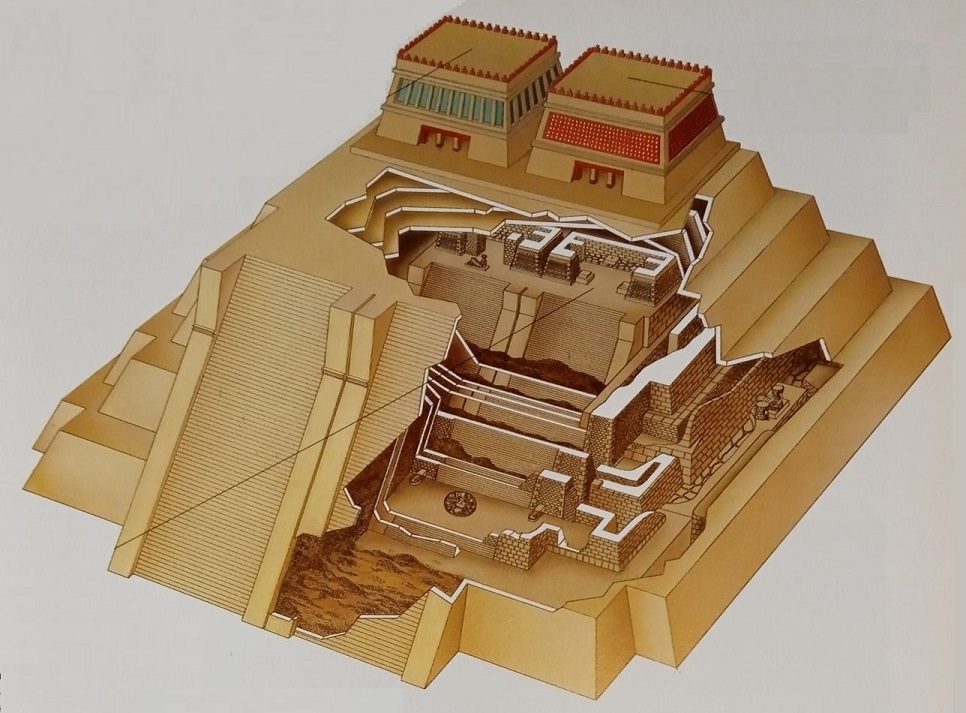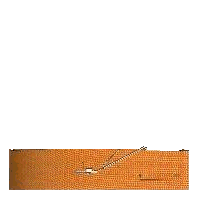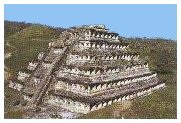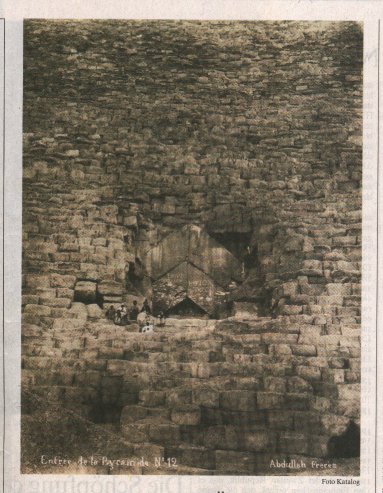This is the idea:
The pyramids
were temples.
The Question:
Where are the unfinished pyramids?
-
A pyramid planned too large
and left unfinished would have the tip missing; on the other hand,
-
A pyramid planned too small
and later enlarged would, perhaps, be missing part of the outer layer.
Some things should be taken
into consideration:
-
The pyramids of ancient
Egypt and the temples of ancient South America are quite similarly
built: for both huge blocks of stone were
joined without a crack; the difference being that in Egypt the stone blocks
had quite a uniform size, while in the earthquake-endangered Andes region
they were of different shapes and sizes; this may have been to avoid resonance.
-
The pyramids of ancient
Egypt were burial chambers.
Inside, in gold-plated sarcophagi, lay the carefully embalmed bodies of her
highest priests and kings (in one person).
But why this effort, if no-one gets to see it?
-
The pyramids of ancient
Egypt have several burial chambers - one above the other.
Stairs lead to the upper ones. Stairs. INSIDE a hill of stones...
-
Burial chambers or -mounds are
generally built in a way that the embalmed corpse to be honored is covered as evenly
as possible with as much material as possible, with stones or earth, and
be it only to make life harder for grave robbers and -desecrators.
In Egypt, though, only the roofed stairs leading to the burial chambers were
blocked. With fatal consequences: they were quickly looted by robbers who
had found access to the stairs.
-
Judging from the form of the
Egyptian pyramids one has already been able to suspect that they are
stone-covered sand hills. After all, sand is plentiful in the vicinity and
must not be expensively be quarried, squared and hauled. It would also represent
the function of the "mound".
As examinations have found, the Egyptian pyramids do indeed not consist
completely of stone but partly of sand and rubble, which may well have served
as a filling between the layers. Only: Which layers?
-
Corpses are traditionally embalmed
if one wants exhibit them, for as long a time as possible and in surroundings
as splendid as possible, not hide them under the earth.
This compares to the embalming of kings and bishops in the Middle Ages and
their exposition in church vaults, and Lenin's eternal rest in his mausoleum,
where, as in the above mentioned church mausolea during the Middle Ages,
an eternal procession of simple people silently filed past, who all physically
wanted to see where the personification of that eternal idea which all of
them were compelled to follow lay.
One must offer the people something to worship.
-
Who knows whether or not
the bodies of kings and priests were not also exhibited on those artificial
stone hills of ancient South America in the small temple shrines at the
top? Indeed, people were even killed there, executed as offerings or
for matters of state.
-
Therefore, these temples were
also places of judgment and execution - of course, not for the ordinary
chicken-thief, but for people of actual or supposed meaning, robbed, bought
or fallen from grace.
This was an exhibition visible over a long distance, a public execution before
an incalculable gawking crowd. Visible over a long distance as everything
monumental, in those times when there were no newspapers, books, radio broadcasts
or television.
As has been said above: one must offer the people something to behold, if
one wants to hold them together as a people.
-
 Pyramid temples of ancient
South America are built on top of one another like Russian dolls;
up to seven layers have been uncovered, for example, in the
Templo Mayor,
so that it contains several older, smaller predecessors. One builder triumphed
(and perhaps later was exhibited there), over his predecessor, without having
to remove him, learned from him, literally built on him, and so produced
progress visible for all - until it could go no further.
Pyramid temples of ancient
South America are built on top of one another like Russian dolls;
up to seven layers have been uncovered, for example, in the
Templo Mayor,
so that it contains several older, smaller predecessors. One builder triumphed
(and perhaps later was exhibited there), over his predecessor, without having
to remove him, learned from him, literally built on him, and so produced
progress visible for all - until it could go no further.
Architects, as do architects of state and religion systems, strive for size
and height, bigger and higher than anything already in existence. And so
the stairs to the top of the temples became longer and longer - and perhaps
also steeper. One must also demand something from the people, if they do
want to come and see - until finally only few still could and were allowed
to come.
-
Since the pyramid temples
of ancient South America are built one upon the other, they contain -
well, what? The stairs and chambers of their predecessors.
The difference to the Egyptian pyramids is that they are hollow and not filled
with sand and rubble.
-
Here it comes now:
What if the "burial chambers" and stairs of the pyramid
temples of ancient Egypt, like the "burial chambers" and
stairs of the pyramid temples of ancient South America, weren't
IN, but ON the pyramids originally, the former being out laid in gold glistening
in the sun (the sun god Ra!) for all to see on a high platform on the outskirts
of the dry desert and shown to the people respectfully filing past, still
breathless from the stairs (and therefore paying for it this way and that)?
And at the same time facilitating a breathtaking view of the landscape during
the day, and of the stars at night.
With or without a dry embalmed priest king, maybe, but already with a (guarded)
golden sarcophagus? Perhaps while work on the renewed encapsulation of the
standing pyramid had already begun down below?
Remember:
You never knew when a Pharaoh was going to die.
He might fall sick, on the battlefield, or prey to murder. How would you
synchronize the finishing of a pyramid - a building project of decades,
at least - with the point of time of his death? You couldn't. It could
be finished before he died; in that case it could have been "open
for public", until his time had come. It could be finished after
he died; in that case you would have to embalm his body to keep, until it
finally was. And embalm it they
did...
These systems were, through the construction time required, projects overreaching
generations and for that alone already have a reference to eternity and a
communal component. A deeper symbolic connection to the hereafter, to eternity
and to one's own short life as well as to one's own greatness or invalidity
in view of eternity could hardly have existed.
What if the construction of the temple pyramids arose from the fact that
the respective temple shrine with the mausoleum on top and the priest king
embalmed there was built over from below by each respective successor? Temple
pyramids then would have been mausolea, and burial chambers former
mausolea.
-
In this case a pyramid, and
be it an ancient Egyptian one, would not have been built from the bottom
to top with a fixed base plan, but in a way from the inside
to the outside with a fixed center.
The exposition of the corpse could have been carried out while the successor
- or oneself, depending on length of life - began to cover the
old with a new layer of stones, by laying a new ring around the base, in
layer upon layer, spiraling, or perhaps towards both sides from the open
stairway on the outside.
This would not only be a most symbolic act: the old is being buried, but
stays visible until the new is in place. It also would facilitate a long
and active farewell, with simultaneous admiration and active mourning.
Then the symbolic roofing of the shrine: what an act! Now the old is visibly
buried, and with that the place for the new also becomes visible; not a peak,
but a platform even higher than the old, with a new shrine, already with
the future sarcophagus of that one which has buried the old and who will
be buried again by the new. An eternal circle.
The king is dead, long live the king!
-
This would, at the same time,
partly answer the question of how the stones were transported to the top;
the ramp would be a part of the new wall or rather the new layer. It would
also be able to explain how granite, which is too hard to be treated with
tools of bronze, could have been worked
into the base of an ancient Egyptian pyramid. It is perhaps only in the outer
ring. Or how the granite sarcophagus fit through the door of the
King's
Chamber (it didn't; it was built around it); or the mystery of the cut-off
(or covered-up) ventilation ducts or
"Star Shafts".
Each new layer of a pyramid represents once more the quantity of material
of the quantity already consumed, and this approximately in weight as well
- this would want to be observed prudently when contemplating to build a
new one. There is a technical limit up to which one can venture and an economic
one. The tip of a pyramid, as in an iceberg, doesn't amount for so much,
depending from where it is supposed to
begin.
-
All in all, the cross-section
of an ancient Egyptian temple pyramid, with its stairs and chambers, hardly
differs from that of an ancient South American pyramid temple -
with the difference, that the pyramid temples of ancient
South America, perhaps because of the surrounding mountainous landscape,
are built more "airily" and steeper than the ancient Egyptian ones built
in the over a long distance flat desert, and, - this makes for the outward
impression - are not like these carefully bricked up and sealed to form
a definite grave-mound.
An ancient Egyptian pyramid would then be a deliberately mortared-up
temple.
This also would be a symbolic act that could hardly be more meaningful. The
past is buried definitely. Something new is built beside it - or is not.
-
In this, another understanding
of the hereafter is perhaps also expressed; Egypt, in the flat desert, orientates
itself more towards the sun, South America, in wooded or rocky mountains,
more towards the stars as the way to the gods. Where are the bodies of its
priest kings?
-
By the way: from Southeast Asia
to East Africa the tradition of building temples is a bit different - here
"negative cities" were carved into rock or enclosed with rock; recognizable
by the trait that the main quantity of stone isn't below but above.
[ Hmm. There could actually
be one more "burial chamber" in the tip of the Cheops pyramid, whose outside
stairway then may have been covered with load-bearing stone blocks towards
the end - just before or during the definite sealing of the pyramid with
tapered limestone blocks, and which therefore remained hidden.
Could. ]
(Move mouse over animation to see proposed chamber)

View the building of the Egyptian pyramids -
animated

Pyramid temple of ancient South America

Entry to the buried Cheops temple of ancient Egypt
|
![]() This probably is because these have an open outer stairway.
This probably is because these have an open outer stairway.